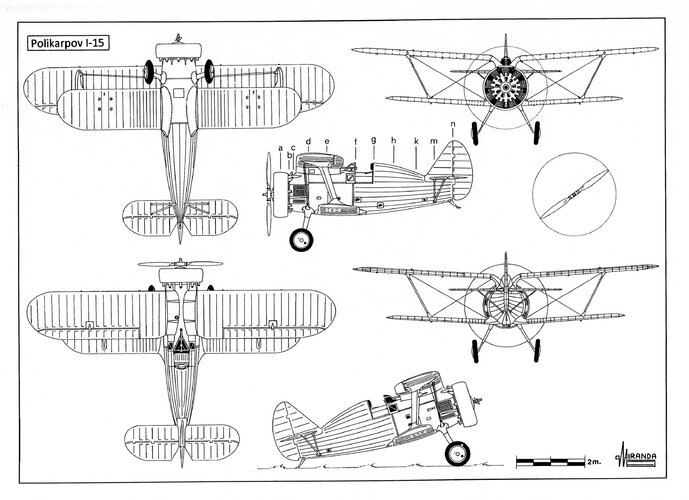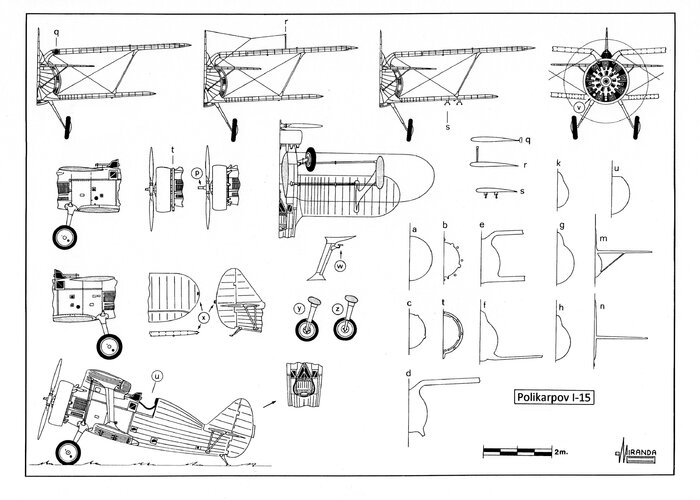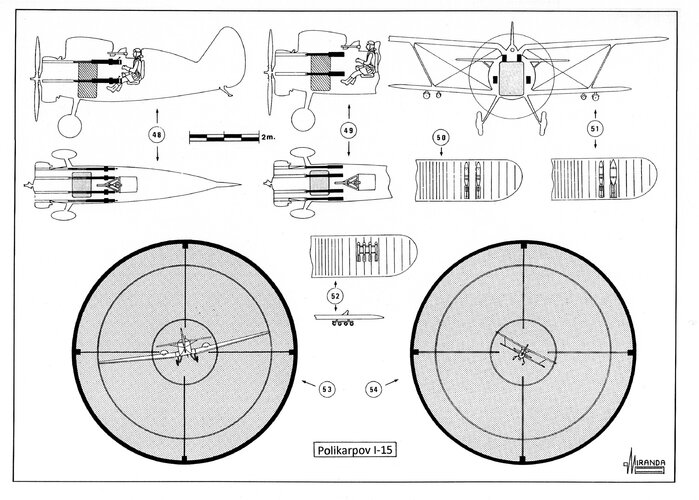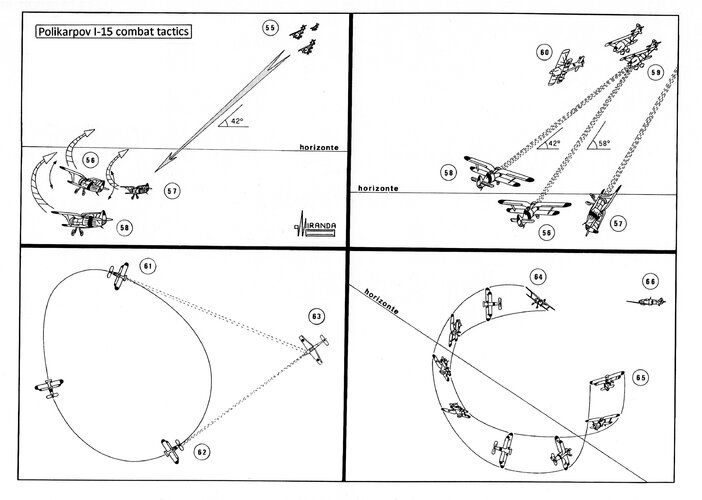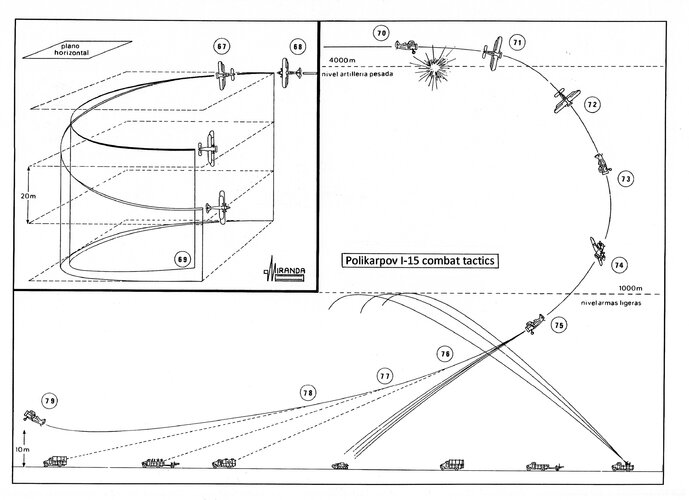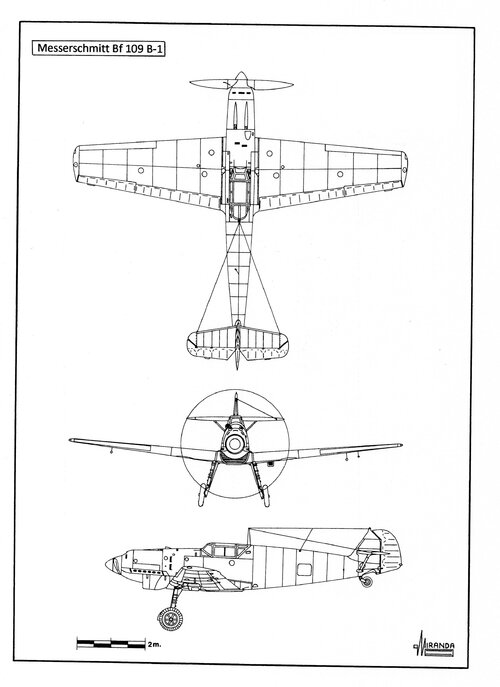Between November 1936 and March 1937, the Polikarpov I-15 fighter proved very useful in the fight against the Nationalist cooperation airplanes Breguet Br. XIX, Aero A-101, Heinkel He 45 and He 46, the bombers Junkers Ju 52/3m, de Havilland DH-89, Fokker F.VII and XII and the fighters Arado Ar 68, Heinkel He 51, Romeo Ro.41 and PWS-10.
It was slower than the Fiat C.R.32 Italian fighter, but surpassed it in maneuverability by making 360 degrees horizontal turns in 8.5 seconds (without a height loss) thanks to the extra side lift of its gull wing (drawings 67, 68 and 69).
Surprised al low altitude by the Fiats, the I-15 reacted by conducting a frontal attack in which the C.R.32's radiator was very vulnerable (drawings 55 to 60).
With 224 mph (360 km/h) top speed and lacked oxygen equipment to combat above 11,480 ft. (3,500 m), the I-15 was unable to catch the 2nd generation German bombers: Dornier Do 17 E with 220 mph (354 km/h) and 16,730 ft. (5,100 m), Do 17F with 222 mph (357 km/h) and 19,685 ft. (6,000 m), Do 17P with 246 mph (396 km/h) and 20,340 ft.(6,200 m), Heinkel He 111B with 230 mph (370 km/h) and 22,966 ft. (7,000 m) and Heinkel He 111E with 227 mph (365 km/h) and 23,620 ft. (7,200 m).
After the arrival in Spain of the new Messerschmitt Bf 109 B-1 fighters, in March 1937, the I-15 fighters were earmarked for ground attack, night fighter and coastal defense missions.
The Germans soon developed ‘hit and run’ tactics that could be used successfully against it. The OP-1 telescopic gunsight restricted the vision of the environment and many I-15 pilots were surprised by dive attacks of the Bf 109s during a strafing mission.
The Soviet OP-1 (Aldis) telescopic gunsight had four collimating lenses, giving a magnification of X 3, and a graticula with two concentric circles indicating the wingspan of a bomber and a fighter (drawings 53 and 54).
The Polikarpov fighters lacked the American automatic starting system of the Boeing 281. Their engines were to be put into operation using a Hucks starter truck that made the propeller turn through a system of pulleys. The procedure was slow and it was customary for the biplanes to take off first to protect the I-16s which small wings without flaps were inefficient to operate from the small and poorly equipped Spanish airfields.
This delayed even more the formation of a fighting force, because according to Soviet air doctrine, the monoplanes were to occupy the higher level. The slowness and clumsiness of the system benefited the Germans, and their fast bombers often managed to surprise the Soviet fighters in the ground, causing heavy losses.
The tactic used by I-15 pilots against ‘hit and run’ attacks was to make a rapid upward turn called the maniobra Pedivalov to try to get behind the aggressor (drawings 64, 65 and 66) and then continue the combat forming a defensive circle of three aircraft (drawings 61, 62 and 63).
In 1937 I-15 pilots were trained in dive bombing tactics in Kirovabad (USSR) and larger trim tabs were installed in the rudder of the aircraft to compensate for vibration during the dive (drawings 70 to 79).
The night fighters were fitted with anti-glare exhausts and RSI-3 radio.
The take-off visibility of the I-15 was very bad and the brake system had to be eliminated on all aircraft because it was the cause of numerous landing accidents.
The VVS standard PV-1 machine gun had a rate of fire of 750 rpm but the propeller-synchronized version had 680 rpm only (drawings 49 and 51).
In 1938 some I-15 fighters were fitted with M-25 engines, armor plates and four ShKAS “S” mod.1937 machine guns with 1,625 rpm (drawing 48) but their synchronization system was unreliable and sometimes all machine guns were accidentally fired upon landing impact, destroying the propeller.
Polikarpov I-15 technical data
Power plant: one M-22 radial engine rated at 480 hp. (Soviet version of Bristol Jupiter VI built under license Gnome-Rhone 9ASB) driving one V-25 metal propeller built under license Hamilton-Standard, wingspan: 30 ft. (9.15 m), length: 20.7 ft. (6.3 m), height: 7.2 ft. (2.19 m), wing surface: 231 sq. ft. (20.8 sq. m), maximum weight: 3,135 lb. (1,420 kg), maximum speed: 224 mph (360 km/h), landing speed: 65 mph (105 km/h), service ceiling: 29,520 ft. (9,000 m), armament: four PV-1 machine guns of 7.62 mm with 680 rpm (drawing 49) or four ShKAS “S” mod.1937 of 7.62 mm machine guns with 1,625 rpm (drawing 48) and 150 kg of bombs (drawings 50, 51 and 52).
It was slower than the Fiat C.R.32 Italian fighter, but surpassed it in maneuverability by making 360 degrees horizontal turns in 8.5 seconds (without a height loss) thanks to the extra side lift of its gull wing (drawings 67, 68 and 69).
Surprised al low altitude by the Fiats, the I-15 reacted by conducting a frontal attack in which the C.R.32's radiator was very vulnerable (drawings 55 to 60).
With 224 mph (360 km/h) top speed and lacked oxygen equipment to combat above 11,480 ft. (3,500 m), the I-15 was unable to catch the 2nd generation German bombers: Dornier Do 17 E with 220 mph (354 km/h) and 16,730 ft. (5,100 m), Do 17F with 222 mph (357 km/h) and 19,685 ft. (6,000 m), Do 17P with 246 mph (396 km/h) and 20,340 ft.(6,200 m), Heinkel He 111B with 230 mph (370 km/h) and 22,966 ft. (7,000 m) and Heinkel He 111E with 227 mph (365 km/h) and 23,620 ft. (7,200 m).
After the arrival in Spain of the new Messerschmitt Bf 109 B-1 fighters, in March 1937, the I-15 fighters were earmarked for ground attack, night fighter and coastal defense missions.
The Germans soon developed ‘hit and run’ tactics that could be used successfully against it. The OP-1 telescopic gunsight restricted the vision of the environment and many I-15 pilots were surprised by dive attacks of the Bf 109s during a strafing mission.
The Soviet OP-1 (Aldis) telescopic gunsight had four collimating lenses, giving a magnification of X 3, and a graticula with two concentric circles indicating the wingspan of a bomber and a fighter (drawings 53 and 54).
The Polikarpov fighters lacked the American automatic starting system of the Boeing 281. Their engines were to be put into operation using a Hucks starter truck that made the propeller turn through a system of pulleys. The procedure was slow and it was customary for the biplanes to take off first to protect the I-16s which small wings without flaps were inefficient to operate from the small and poorly equipped Spanish airfields.
This delayed even more the formation of a fighting force, because according to Soviet air doctrine, the monoplanes were to occupy the higher level. The slowness and clumsiness of the system benefited the Germans, and their fast bombers often managed to surprise the Soviet fighters in the ground, causing heavy losses.
The tactic used by I-15 pilots against ‘hit and run’ attacks was to make a rapid upward turn called the maniobra Pedivalov to try to get behind the aggressor (drawings 64, 65 and 66) and then continue the combat forming a defensive circle of three aircraft (drawings 61, 62 and 63).
In 1937 I-15 pilots were trained in dive bombing tactics in Kirovabad (USSR) and larger trim tabs were installed in the rudder of the aircraft to compensate for vibration during the dive (drawings 70 to 79).
The night fighters were fitted with anti-glare exhausts and RSI-3 radio.
The take-off visibility of the I-15 was very bad and the brake system had to be eliminated on all aircraft because it was the cause of numerous landing accidents.
The VVS standard PV-1 machine gun had a rate of fire of 750 rpm but the propeller-synchronized version had 680 rpm only (drawings 49 and 51).
In 1938 some I-15 fighters were fitted with M-25 engines, armor plates and four ShKAS “S” mod.1937 machine guns with 1,625 rpm (drawing 48) but their synchronization system was unreliable and sometimes all machine guns were accidentally fired upon landing impact, destroying the propeller.
Polikarpov I-15 technical data
Power plant: one M-22 radial engine rated at 480 hp. (Soviet version of Bristol Jupiter VI built under license Gnome-Rhone 9ASB) driving one V-25 metal propeller built under license Hamilton-Standard, wingspan: 30 ft. (9.15 m), length: 20.7 ft. (6.3 m), height: 7.2 ft. (2.19 m), wing surface: 231 sq. ft. (20.8 sq. m), maximum weight: 3,135 lb. (1,420 kg), maximum speed: 224 mph (360 km/h), landing speed: 65 mph (105 km/h), service ceiling: 29,520 ft. (9,000 m), armament: four PV-1 machine guns of 7.62 mm with 680 rpm (drawing 49) or four ShKAS “S” mod.1937 of 7.62 mm machine guns with 1,625 rpm (drawing 48) and 150 kg of bombs (drawings 50, 51 and 52).

